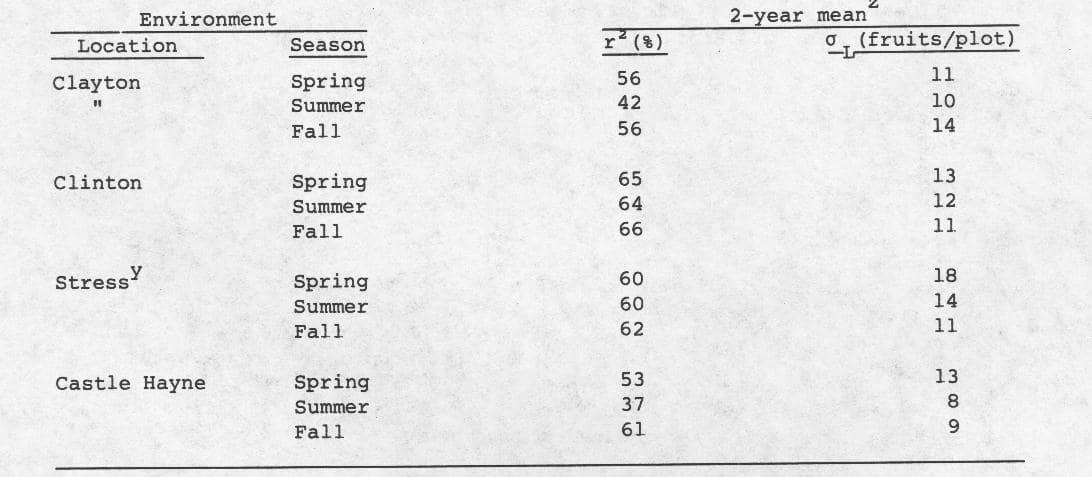Cucurbit Genetics Cooperative Report 10:27-28 (article 17) 1987
Todd Wehner
Department of Horticultural Science, North Carolina State University, Raleigh, NC 27695-7609
New experimental breeding lines of pickling and fresh-market cucumbers are tested in many North Carolina environments before release as cultivars for use in the state. The early stages of testing are most efficiently done using 2 to 3 replications per entry harvested once-over when the check cultivar has 10% oversized fruits (3, 4). The optimum plot size for such trials is approximately 1.5 x 1.5m (2).
The most efficient component of environment to use as the factor for repetition is years, followed by seasons, locations, and, finally, replications (5). However, additional years of testing add greatly to the time required to complete a cycle of selection and pollination. Therefore, it may be best to use season-location combinations as the method of sampling the environment before releasing an experimental. line as a new cultivar. A number of methods have been proposed for choosing the ideal environment (1). The best environments for testing new lines for use in a region are representative of the region, and provide maximum separation of the lines involved. In other words, a good environment should be correlated with the mean of all environments, and have a large standard deviation among line means.
The objective of this study was to determine which season-location combinations make the best testing environments for use in initial testing of experimental lines in North Carolina.
Methods. A random set of hybrids, inbreds, cultivars and experimentals was tested in North Carolina for yield and quality. The 44 lines were chosen to represent new and old, tall and dwarf, resistant and susceptible (to southern foliar diseases), and pickling and fresh-market types (22 lines each).
Plots were 25-plant rows 1.5 m long and 1.5 m apart seeded on raised beds. The environments consisted of 2 years (1984, 1985), 3 seasons (spring, summer, fall), 4 locations (Clayton, Clinton, Castle Hayne and a stress field in Clinton), and 2 replications. The stress environment consisted of heavier soil and only half the irrigation, fertilization and pesticide applications given the main Clinton location. Yield was measured as fruit number in a single-harvest trial. Harvest was made when 10% of the fruits were oversized in the check plots (‘Calypso’ for pickling and ‘Poinsett 76’ for fresh-market genotypes).
Results. The correlations for line performance at each of the 12 seasonlocation environments with line performance over all environments were all significant at the 1% level (data not shown). However, coefficients of determination (r2) and standard deviations for line means ([sigma]L) were highest at the Clinton and Stress locations for all seasons tested (Table 1). No other season-location combinations had both high r2 and high [sigma]L.
Therefore, a test involving 2 plots per line could be run efficiently using a spring season at the Clinton and Stress locations (in May and June), leaving enough time to intercross or self-pollinate the best lines before the end of the growing season (in July through September).
Table 1. Coefficients of determination (r2) and standard deviations of line means ( [sigma]L) for 16 location-season combinations evaluated for usefulness as yield trial environments in North Carolina.

z Data are from 1984 and 1985 tests of 22 pickling and 22 fresh-market cucumber lines.
y Stress location was at Clinton, with low inputs of fertilizer, pesticides and irrigation.
Literature Cited
- Brown, K.D., M.E. Sorrells and W.R. Coffman. 1983. A method for classification and evaluation of testing environments. Crop Sci. 23:889- 893.
- Swallow, W.H. and T.C. Wehner. 1986. Optimum plot size determination and its application to cucumber yield trials. Euphytica 35:421-432.
- Wehner, T.C. 1986. Efficiency of 3 single-harvest trials for evaluation of yield in pickling cucumber. Euphytica 35:493-501.
- Wehner, T.C. and C.H. Miller. 1986. Efficiency of single-harvest methods for measurement of yield in fresh-market cucumbers. J. Amer. Soc. Hort. Sci. 109:659-664.
- Wehner, T.C. and W.H. Swallow. 1986. Optimum allocation of plots into years, seasons, locations and replications for once-over harvest trials of cucumber. Cucurbit Genet. Coop. Rpt. 9:44-46.